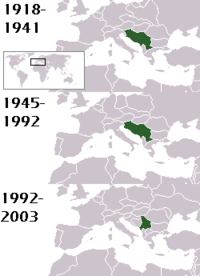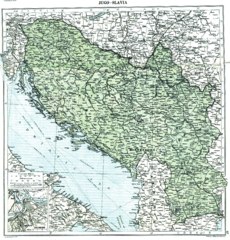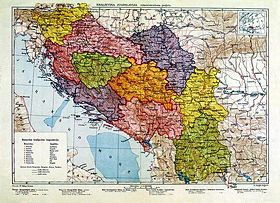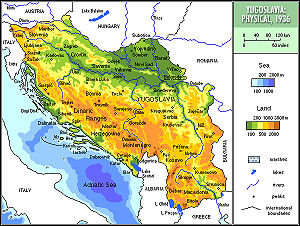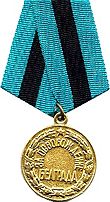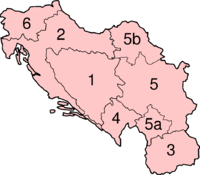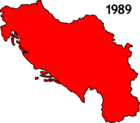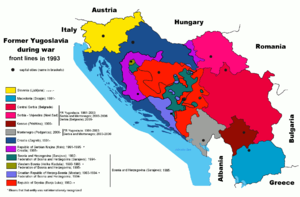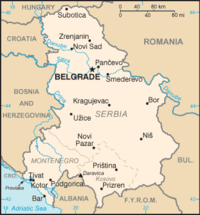Yugoslavia
2008/9 Schools Wikipedia Selection. Related subjects: General history
Yugoslavia ("Jugoslavija" in Serbo-Croatian ( Latin alphabet) and Slovenian; "Југославија" in Serbian ( Cyrillic alphabet) and Macedonian; English: "South Slavia", or literally The Land of South Slavs) describes three political entities that existed successively on the Balkan Peninsula in Europe, during most of the 20th century.
The first country to be known by this name was the " Kingdom of Yugoslavia", which before 3 October 1929 was known as the "Kingdom of Serbs, Croats and Slovenes". It was established on 1 December 1918 by the union of the State of Slovenes, Croats and Serbs and the Kingdom of Serbia. It was invaded by the Axis powers in 1941, and because of the events that followed, was officially abolished in 1945.
The country with this name was "Democratic Federal Yugoslavia", proclaimed in 1943 by the communist resistance movement in World War II. It was renamed to the "Federal People's Republic of Yugoslavia" in 1946, when a communist government was established. In 1963, it was renamed again to the " Socialist Federal Republic of Yugoslavia" (SFRY). The constituent Socialist Republics that made up the country, from north to south, were: SR Slovenia, SR Croatia, SR Bosnia and Herzegovina, SR Montenegro, SR Serbia (including the autonomous provinces of Vojvodina and Kosovo and Metohija, later simply Kosovo) and SR Macedonia. Starting in 1991, the SFRY disintegrated in the Yugoslav Wars which followed the secession of most of the republic's constituent entities.
The last country to bear the name was the " Federal Republic of Yugoslavia" (FRY) established on March 27, 1992. It was a federation on the territory of the two remaining (non-secessionist) republics of Serbia (including the autonomous provinces of Vojvodina and Kosovo) and Montenegro. On February 4, 2003, it was renamed to the "State Union of Serbia and Montenegro", and officially abolished the name "Yugoslavia." On June 3 and June 5, 2006, Montenegro and Serbia respectively declared their independences, thereby ending the last remnants of a Yugoslav state.
Background
The idea for a single state for all South Slavs emerged in the late 17th century and gained prominence in the 19th century Illyrian Movement but never came to culmination.
During the early period of World War I, a number of prominent political figures from South Slavic lands under the Habsburg Austro-Hungarian Empire fled to London, where they began work on forming the Yugoslav Committee to represent the Southern Slavs of Austria-Hungary. These "Yugoslavs" were Serbs, Croats, and Slovenes who identified themselves with the movement toward a single Yugoslav or South Slavic state and the committee's basic aim was the unification of the South Slav lands with the Kingdom of Serbia (which was independent although occupied at the time).
With the defeat of the Central Powers in World War I and the collapse of the Austro-Hungarian Empire, various South Slavic territories were quickly grouped together to form the Kingdom of Serbs, Croats and Slovenes which was proclaimed on 1 December 1918 in Belgrade .
The new kingdom was made up of the formerly independent kingdoms of Serbia and Montenegro (which had unified in the previous month), as well as a substantial amount of territory that was formerly part of Austria-Hungary, the State of Slovenes, Croats and Serbs. The lands previously in Austria-Hungary that formed the new state included Croatia, Slavonia and Vojvodina from the Hungarian part of the Empire, Carniola, part of Styria and most of Dalmatia from the Austrian part, and the crown province of Bosnia and Herzegovina.
Kingdom of Serbs, Croats and Slovenes
1918-1928
- Vidovdan Constitution
- Treaty of Rapallo, 1920
- Banning of the Communist Party
- Election 1923
- Treaty of Rome, 1924
- Assassination of Stjepan Radić
King Alexander's Period
King Alexander I banned national political parties in 1929, assumed executive power and renamed the country Yugoslavia. He hoped to curb separatist tendencies and mitigate nationalist passions. However, Alexander's policies soon ran into the obstacle of opposition from other European powers stemming from developments in Italy and Germany, where Fascists and Nazis rose to power, and the Soviet Union, where Stalin became absolute ruler. None of these three regimes favored the policy pursued by Alexander I. In fact, Italy and Germany wanted to revise the international treaties signed after World War I, and the Soviets were determined to regain their positions in Europe and pursue a more active international policy.
Alexander attempted to create a genuine Yugoslavia. He decided to abolish Yugoslavia's historic regions, and new internal boundaries were drawn for provinces or banovinas. The banovinas were named after rivers. Many politicians were jailed or kept under tight police surveillance. The effect of Alexander's dictatorship was to further alienate the non-Serbs from the idea of unity.
The king was assassinated in Marseille during an official visit to France in 1934 by an experienced marksman from Ivan Mihailov's Internal Macedonian Revolutionary Organization in the cooperation of the Ustaše, a Croatian separatist organization. Alexsandar was succeeded by his eleven year old son Peter II and a regency council headed by his cousin Prince Paul.
The 1930s in Yugoslavia
The international political scene in the late 1930s was marked by growing intolerance between the principal figures, by the aggressive attitude of the totalitarian regimes and by the certainty that the order set up after World War I was losing its strongholds and its sponsors were losing their strength. Supported and pressured by Fascist Italy and Nazi Germany, Croatian leader Vlatko Maček and his party managed the creation of the Croatian banovina (administrative province) in 1939. The agreement specified that Croatia was to remain part of Yugoslavia, but it was hurriedly building an independent political identity in international relations.
Prince Paul submitted to the fascist pressure and signed the Tripartite Treaty in Vienna on March 25, 1941, hoping to still keep Yugoslavia out of the war. But this was at the expense of popular support for Paul's regency. Senior military officers were also opposed to the treaty and launched a coup d'état when the king returned on March 27. Army General Dušan Simović seized power, arrested the Vienna delegation, exiled Paul, and ended the regency, giving 17 year old King Peter full powers.
The beginning of World War II in Yugoslavia
Hitler then decided to attack Yugoslavia on April 6, 1941, followed immediately by an invasion of Greece where Mussolini had previously been repelled. (As a result, the launch of Operation Barbarossa was delayed by four weeks, which proved to be a costly decision.)
Yugoslavia during World War II
The invasion of Yugoslavia
At 5:12 a.m. on April 6, 1941, German, Italian, Hungarian, and Bulgarian forces attacked Yugoslavia. The German Air Force (Luftwaffe) bombed Belgrade and other major Yugoslav cities. On April 17, representatives of Yugoslavia's various regions signed an armistice with Germany at Belgrade, ending eleven days of resistance against the invading German Army ( Wehrmacht Heer). More than three hundred thousand Yugoslav officers and soldiers were taken prisoner.
The Axis Powers occupied Yugoslavia and split it up. The Independent State of Croatia was established as a Nazi puppet state, ruled by the fascist militia known as the Ustaše that came into existence in 1929, but was relatively limited in its activities until 1941. German troops occupied Bosnia and Herzegovina as well as part of Serbia and Slovenia, while other parts of the country were occupied by Bulgaria, Hungary, and Italy. During this time the Independent State of Croatia created concentration camps for anti-fascists, communists, Serbs, Gypsies and Jews. One such camp was Jasenovac. A large number of men, women and children, mostly Serbs, were executed in these camps.
Resistance movements
Yugoslavs opposing the Nazis organized a resistance movement. Those inclined towards supporting the old Kingdom of Yugoslavia joined the Yugoslav Army in the Fatherland, also known as the Chetniks, Serb royalist guerrilla army led by Dragoljub "Draža" Mihailović. Those inclined towards supporting the Communist Party (Komunistička partija), and were against the King, joined the Yugoslav National Liberation Army (Narodno Oslobodilačka Vojska or NOV), led by Josip Broz Tito, a Croatian national. Chetniks were allies of United States in Europe and they saved over 150 American pilots during operation : "Vazdušni Most".
The NOV initiated a guerrilla campaign which was developed into the largest resistance army in occupied Western and Central Europe. The Chetniks initially made notable incursions and were supported by the exiled royal government as well as the Allies, but were soon restrained from taking wider actions because of German reprisals against the Serb civilian population.
For every killed soldier, the Germans executed 100 civilians, and for each wounded, they killed 50. Regarding the human cost as too high, the Chetniks terminated war activities against the Germans, and the Allies eventually switched to support the NOV.
However, NOV carried on its guerrilla warfare. The demographic loss is estimated at 1,027,000 individuals by Vladimir Zerjavic and Bogoljub Kočović, an estimate accepted by the United Nations, while the official Yugoslav authorities claimed 1,700,000 casualties. Very high losses were among Serbs who lived in Bosnia and Croatia, as well as Jewish and Roma minorities, high also among all other non- collaborating population.
During the war, the communist-led partisans were de facto rulers on the liberated territories, and the NOV organized people's committees to act as civilian government. In Autumn of 1941, the partisans established the Republic of Užice in the liberated territory of western Serbia. In November 1941, the German troops occupied this territory again, while the majority of partisan forces escaped towards Bosnia.
On November 25, 1942, the Anti-Fascist Council of National Liberation of Yugoslavia (Antifašističko Vijeće Narodnog Oslobođenja Jugoslavije) was convened in Bihać, Bosnia. The council reconvened on November 29, 1943, in Jajce, also in Bosnia and established the basis for post-war organisation of the country, establishing a federation (this date was celebrated as Republic Day after the war).
The liberation of Yugoslavia
The NOV was able to expel the Axis from Serbia in 1944 and the rest of Yugoslavia in 1945. The Red Army aided in liberating Belgrade as well as some other territories, but withdrew after the war was over. In May 1945, NOV met with allied forces outside former Yugoslav borders, after taking over also Trieste and parts of Austrian southern provinces Styria and Carinthia. This was territory populated predominantly by Italians and Slovenes. However, the NOV withdrew from Trieste in June of the same year.
Western attempts to reunite the partisans, who denied supremacy of the old government of the Kingdom of Yugoslavia, and the emigration loyal to the king, led to the Tito-Šubašić Agreement in June 1944, however Tito was seen as a national hero by the citizens, so he gained the power in post-war independent communist state, starting as a prime minister.
The Second Yugoslavia
On January 31, 1946, the new constitution of Federal People's Republic of Yugoslavia, modeling the Soviet Union, established six Socialist Republics, a Socialist Autonomous Province, and a Socialist Autonomous District that were part of SR Serbia. The federal capital was Belgrade. Republics and provinces were (in alphabetical order):
- Socialist Republic of Bosnia and Herzegovina, with the capital in Sarajevo,
- Socialist Republic of Croatia, with the capital in Zagreb,
- Socialist Republic of Macedonia, with the capital in Skopje,
- Socialist Republic of Montenegro, with the capital in Titograd (now Podgorica),
- Socialist Republic of Serbia, with the capital in Belgrade, which also contained:
5a. Socialist Autonomous Province of Kosovo and Metohija, with the capital in Priština
5b. Socialist Autonomous Province of Vojvodina, with the capital in Novi Sad - Socialist Republic of Slovenia, with the capital in Ljubljana.
In 1974, the two provinces of Vojvodina and Kosovo-Metohija (for the latter had by then been upgraded to the status of a province), as well as the republics of Bosnia & Herzegovina and Montenegro, were granted greater autonomy to the point that Albanian and Hungarian became nationally recognised minority languages and the Serbo-Croat of Bosnia and Montenegro altered to a form based on the speech of the local people and not on the standards of Zagreb and Belgrade.
Vojvodina and Kosovo-Metohija form a part of the Republic of Serbia. The country distanced itself from the Soviets in 1948 (cf. Cominform and Informbiro) and started to build its own way to socialism under the strong political leadership of Josip Broz Tito. The country criticized both Eastern bloc and NATO nations and, together with other countries, started the Non-Aligned Movement in 1961, which remained the official affiliation of the country until it dissolved.
Demographics
The population of Yugoslavia according to the 1981 census was 22.4 million.
Changes in Yugoslavian Religious Demographics
The government
On 7 April 1963 the nation changed its official name to Socialist Federal Republic of Yugoslavia and Tito was named President for Life.
In SFRY, each republic and province had its own constitution, supreme court, parliament, president and prime minister. At the top of the Yugoslav government were the President (Tito), the federal Prime Minister, and the federal Parliament (a collective Presidency was formed after Tito's death in 1980).
Also important were the Communist Party general secretaries for each republic and province, and the general secretary of Central Committee of the Communist Party.
Josip Broz Tito was the most powerful person in the country, followed by republican and provincial premiers and presidents, and Communist Party presidents. A wide variety of people suffered from his disfavor. Slobodan Penezić Krcun, Tito's chief of secret police in Serbia, fell victim to a dubious traffic incident after he started to complain about Tito's politics. The Interior Minister Aleksandar Ranković lost all of his titles and rights after a major disagreement with Tito regarding state politics. Sometimes ministers in government, such as Edvard Kardelj or Stane Dolanc, were more important than the Prime Minister.
The suppression of national identities escalated with the so-called Croatian Spring of 1970-1971, when students in Zagreb organized demonstrations for greater civil liberties and greater Croatian autonomy. The regime stifled the public protest and incarcerated the leaders, but many key Croatian representatives in the Party silently supported this cause, so a new Constitution was ratified in 1974 that gave more rights to the individual republics in Yugoslavia and provinces in Serbia.
Ethnic tensions and the economic crisis
The post-World War II Yugoslavia was in many respects a model of how to build a multinational state. The Federation was constructed against a double background: an inter-war Yugoslavia which had been dominated by the Serbian ruling class; and a war-time division of the country, as Fascist Italy and Nazi Germany split the country apart and endorsed an extreme Croatian nationalist faction called the Ustashe which committed genocide against Serbs. Some Bosniak nationalists joined the Axis forces and attacked Serbs. In response extreme Serb nationalists engaged in revenge attacks on Bosniaks and Croats.
The ethnic violence was only ended when the multiethnic Yugoslav Partisans took over the country at the end of the war and banned nationalism from being publicly promoted. Overall relative peace was retained under Tito's rule, though nationalist protests did occur, but these were usually repressed and nationalist leaders were arrested and some were executed by Yugoslav officials. However one protest in Croatia in the 1970s, called the " Croatian Spring" was backed by large numbers of Croats who claimed that Yugoslavia remained a Serb hegemony and demanded that Serbia's powers be reduced. Tito whose home republic was Croatia was concerned over the stability of the country and responded in a manner to appease both Croats and Serbs, he ordered the arrest of the Croat protestors, while at the same time conceding to some of their demands. In 1974, Serbia's influence in the country was significantly reduced as autonomous provinces were created in ethnic Albanian-majority populated Kosovo and the mixed-populated Vojvodina. These autonomous provinces held the same voting power as the republics but unlike the republics, they could not legally separate from Yugoslavia. This concession satisfied Croatia and Slovenia, but in Serbia and in the new autonomous province of Kosovo, reaction was different. Serbs saw the new constitution as conceding to Croat and ethnic Albanian nationalists. Ethnic Albanians in Kosovo saw the creation of an autonomous province as not being enough, and demanded that Kosovo become a constituent republic with the right to separate from Yugoslavia. This created tensions within the Communist leadership, particularly amongst Communist Serb officials who resented the 1974 constitution as weakening Serbia's influence and jeoprodizing the unity of the country by allowing the republics the right to separate.
An economic crisis erupted in the 1970s was the product of disastrous errors by Yugoslav governments, such as borrowing vast amounts of Western capital in order to fund growth through exports. Western economies then entered recession, blocked Yugoslav exports and created a huge debt problem. The Yugoslav government then accepted the IMF's conditionalities which shifted the burden of the crisis onto the Yugoslav working class. Simultaneously, strong social groups emerged within the Yugoslav Communist Party, allied to Western business, banking and state interests and began pushing towards neoliberalism, to the delight of the US. It was the Reagan administration which, in 1984, had adopted a " Shock Therapy" proposal to push Yugoslavia towards a capitalist restoration.
In 1989 Jeffrey Sachs was in Yugoslavia helping the Federal government under Ante Marković prepare the IMF/World Bank " Shock Therapy" package, which was then introduced in 1990 just at the time when the crucial parliamentary elections were being held in the various republics.
One aspect of Yugoslavia's " Shock Therapy" programme was both unique within the region and of great political importance in 1989-90. The bankruptcy law to liquidate state enterprises was enacted in the 1989 Financial Operations Act which required that if an enterprise was insolvent for 30 days running, or for 30 days within a 45 day period, it had to settle with its creditors either by giving them ownership or by being liquidated, in which case workers would be sacked, normally without severance payments.
In 1989, according to official sources, 248 firms were declared bankrupt or were liquidated and 89,400 workers were laid off. During the first nine months of 1990 directly following the adoption of the IMF programme, another 889 enterprises with a combined work-force of 525,000 workers suffered the same fate. In other words, in less than two years "the trigger mechanism" (under the Financial Operations Act) had led to the lay off of more than 600,000 workers out of a total industrial workforce of the order of 2.7 million. A further 20% of the work force, or half a million people, were not paid wages during the early months of 1990 as enterprises sought to avoid bankruptcy. The largest concentrations of bankrupt firms and lay-offs were in Serbia, Bosnia and Herzegovina, Macedonia and Kosovo. Real earnings were in a free fall, social programmes had collapsed creating within the population an atmosphere of social despair and hopelessness. This was a critical turning point in the events to follow.
In the spring of 1990, Marković was by far the most popular politician, not only in Yugoslavia as a whole, but in each of its constituent republics. He should have been able to rally the population for Yugoslavism against the particularist nationalisms of Milošević in Serbia or Tuđman in Croatia and he should have been able to count on the obedience of the armed forces. He was supported by 83% of the population in Croatia, by 81% in Serbia and by 59% in Slovenia and by 79% in Yugoslavia as a whole. This level of support showed how much of the Yugoslav population remained strongly committed to the state's preservation.
But Marković had coupled his Yugoslavism with the IMF " Shock Therapy" programme and EC conditionality and it was this which gave the separatists in the North West and the nationalists in Serbia their opening. The appeal of the separatists in Slovenia and Croatia to their electorates involved offering to repudiate the Marković-IMF austerity and by doing so help their republics prepare to leave Yugoslavia altogether and "join Europe". The appeal of Milošević in Serbia was based around the idea that the West was acting against the Serbian people's interests. These nationalist appeals were ultimately successful: in every republic, beginning with Slovenia and Croatia in the spring, governments ignored the monetary restrictions of Marković's stabilisation programme in order to win votes.
The newly elected regional government then turned their efforts to the break-up of the country. They were aided by the US government's stance of sidelining Yugoslav cohesion in favour of pushing ahead with the " Shock Therapy" programme. The few European states with strategic interests in the Yugoslav theatre tended to favour fragmentation.
There were also other specifically Yugoslav, structural flaws which helped to generate the collapse. For instance, many would argue that the decentralized Market Socialism was a disastrous experiment for a state in Yugoslavia's geopolitical situation. The 1974 Constitution, though better for the Kosovar Albanians, had given increased power to the republics, whilst dampening the institutional and material power of the federal government. Tito's authority substituted for this weakness until his death in 1980, after which the state and Communist Party became increasingly paralyzed and thrown into crisis.
Breakup
After Tito's death on 4 May 1980, ethnic tensions grew in Yugoslavia. The legacy of the Constitution of 1974 was used to throw the system of decision-making into a state of paralysis, made all the more hopeless as the conflict of interests had become irreconcilable. The constitutional crisis that inevitably followed resulted in a rise of nationalism in all republics: Slovenia and Croatia made demands for looser ties within the Federation, the Albanian majority in Kosovo demanded the status of a republic, Serbia sought absolute, not only relative dominion over Yugoslavia. Added to this, the Croat quest for independence led to large Serb communities within Croatia rebelling and trying to secede from the Croat republic.
In 1986, the Serbian Academy of Sciences and Arts drafted a memorandum addressing some burning issues concerning position of Serbs as the most numerous people in Yugoslavia. The largest Yugoslav republic in territory and population, Serbia's influence over the regions of Kosovo and Vojvodina was reduced by the 1974 Constitution. Because its two autonomous provinces had de facto prerogatives of full-fledged republics, Serbia found that its hands were tied, for the republican government was restricted in making and carrying out decisions that would apply to the provinces. Since the provinces had a vote in the Federal Presidency Council (an eight member council composed of representatives from six republics and two autonomous provinces), they sometimes even entered into coalition with other republics, thus outvoting Serbia. Serbia's political impotence made it possible for others to exert pressure on the 2 million Serbs (20% of total Serbian population) living outside Serbia.
Serbian communist leader Slobodan Milošević sought to restore pre-1974 Serbian sovereignty. Other republics, especially Slovenia and Croatia, denounced this move as a revival of great Serbian hegemonism. Milošević succeeded in reducing the autonomy of Vojvodina and of Kosovo and Metohija, but both entities retained a vote in the Yugoslav Presidency Council. The very instrument that reduced Serbian influence before was now used to increase it: in the eight member Council, Serbia could now count on four votes minimum - Serbia proper, then-loyal Montenegro, and Vojvodina and Kosovo.
As a result of these events, the ethnic Albanian miners in Kosovo organized strikes, which dovetailed into ethnic conflict between the Albanians and the non-Albanians in the province. At 87% of the population of Kosovo in the 1980s, ethnic-Albanians were the majority. The number of Slavs in Kosovo (mainly Serbs) was quickly declining for several reasons, among them the ever increasing ethnic tensions and subsequent emigration from the area. By 1999 the Slavs formed as little as 10% of the total population in Kosovo.
Meanwhile Slovenia, under the presidency of Milan Kučan, and Croatia supported Albanian miners and their struggle for formal recognition. Initial strikes turned into widespread demonstrations demanding a Kosovan republic. This angered Serbia's leadership which proceeded to use police force, and later even the Federal Army was sent to the province by the order of the Serbia-held majority in the Yugoslav Presidency Council.
In January 1990, the extraordinary 14th Congress of the League of Communists of Yugoslavia was convened. For most of the time, the Slovenian and Serbian delegations were arguing over the future of the League of Communists and Yugoslavia. The Serbian delegation, led by Milošević, insisted on a policy of "one person, one vote", which would empower the majority population, the Serbs. In turn, the Slovenes, supported by Croats, sought to reform Yugoslavia by devolving even more power to republics, but were voted down. As a result, the Slovenian, and eventually Croatian delegation left the Congress, and the all-Yugoslav Communist party was dissolved.
Following the fall of communism in the rest of Eastern Europe, each of the republics held multi-party elections in 1990. Slovenia and Croatia held the elections in April since their communist parties chose to secede from power peacefully. Other Yugoslav republics - especially Serbia - were more or less dissatisfied with the democratization in two of the republics and proposed different sanctions (e.g. Serbian "customs tax" for Slovenian products) against the two of the union but as the year passed other republics communist parties saw the inevitability of the democratization process and in December as the last member of the federation - Serbia held parliamentary elections which confirmed (former) communists rule in this republic. The unresolved issues however remained. In particular, Slovenia and Croatia elected governments oriented towards greater authonomy of the republics (under Milan Kučan and Franjo Tuđman, respectively), since it became clear that Serbian domination attempts and increasingly different levels of democratic standards are becoming increasingly incompatible. Serbia and Montenegro elected candidates who favoured Yugoslav unity. Serbs in Croatia wouldn't accept a status of a national minority in a sovereign Croatia, since they would be demoted from a constituent nation of Croatia and this would consequently diminish their rights.
The War
The war broke out when the new regimes tried to replace Yugoslav civilian and military forces by the secessionist forces. When in August 1990 Croatia attempted to replace police in the Serb populated Croat Krajina by force, the population first looked for refuge in the JNA caserns, while the army remained passive. The civilians then organised armed resistance. These armed conflicts between the Croatian armed forces (“police”) and civilians mark the beginning of the Yugoslav war that inflamed the region. Similarly, the attempt to replace Yugoslav frontier police by the Slovenian police provoked regional armed conflicts which finished with a minimal number of victims. A similar attempt in Bosnia and Herzegovina led to a war that lasted more than 3 years (see below). The results of all these conflicts are almost complete emigration of the Serbs from all three regions, massive displacement of the populations in Bosnia and Herzegovina and establishment of the 3 new independent states. The separation of the Yugoslav Republic of Macedonia was peaceful.
Serbian uprisings in Croatia began in August 1990 by blocking roads leading from the Dalmatian coast towards the inland almost a year before Croatian leadership made any move towards independence. These uprisings were more or less discretely backed up by the Serbian dominated federal army (JNA). The Serbs proclaimed the emergence of Serbian Autonomous Areas (known later as Republic of Serb Krajina) in Croatia. Federal army tried to disarm the Territorial defence forces of Slovenia (republics had their local defence forces similar to Home guard ) in 1990 but wasn't completely successful. Still Slovenia began to covertly import arms to replenish its armed forces. Croatia also embarked upon the illegal importation of arms, (following the disaramament of the republics armed forces by the federal JNA) mainly from Hungary, and were caught when Yugoslav Counter Intelligence (KOS, Kontra-obavještajna Služba) showed a video of a secret meeting between Croatian Defence Minister Martin Špegelj and two men. Špegelj announced that they were at war with the army and gave instructions about arms smuggling as well as methods of dealing with the Yugoslav Army's officers stationed in Croatian cities. Serbia and JNA used this discovery of Croatian rearmament for propaganda purposes.
In March 1990, during the demonstrations in Split, Croatia, a young Yugoslav conscript was pushed off a tank after driving it through a crowd of people. Also, guns were fired from army bases through Croatia. Elsewhere, tensions were running high.
In the same month, the Yugoslav People's Army (Jugoslovenska Narodna Armija, JNA) met with the Presidency of Yugoslavia in an attempt to get them to declare a state of emergency which would allow for the army to take control of the country. The army was seen as a Serbian service by that time so the consequence feared by the other republics was to be total Serbian domination of the union. The representatives of Serbia, Montenegro, Kosovo and Metohija, and Vojvodina voted for the decision, while all other republics, Croatia ( Stipe Mesić), Slovenia ( Janez Drnovšek), Macedonia ( Vasil Tupurkovski) and Bosnia and Hercegovina ( Bogić Bogićević), voted against. The tie delayed an escalation of conflicts, but not for long.
Following the first multi-party election results, in the autumn of 1990, the republics of Slovenia and Croatia proposed transforming Yugoslavia into a loose confederation of six republics. By this proposal republics would have right to self-determination. However Milošević rejected all such proposals, arguing that like Slovenes and Croats, the Serbs (having in mind Croatian Serbs) should also have a right to self-determination.
On March 9, 1991, demonstrations were held against Slobodan Milošević in Belgrade, but the police and the military were deployed in the streets to restore order, killing two people. In late March 1991, the Plitvice Lakes incident was one of the first sparks of open war in Croatia. The Yugoslav People's Army (JNA), whose superior officers were mainly of Serbian ethnicity, maintained an impression of being neutral, but as time went on, they got more and more involved in the state politics.
On June 25, 1991, Slovenia and Croatia became the first republics to declare independence from Yugoslavia. The federal customs officers in Slovenia on the border crossings with Italy, Austria and Hungary mainly just changed uniforms since most of them were local Slovenes. The border police was already Slovenian before declaring independence. The following day ( June 26), the Federal Executive Council specifically ordered the army to take control of the "internationally recognized borders". See Ten-Day War .
The Yugoslav People's Army forces, based in barracks in Slovenia and Croatia, attempted to carry out the task within next 48 hours. However, because of the misinformation given to the Yugoslav Army conscripts that the Federation is under attack by foreign forces, and the fact that the majority of them did not wish to engage in a war on the ground where they served their conscription, the Slovene territorial defence forces retook most of the posts within several days with only minimal loss of life on both sides. There was a suspected incident of a war crime, as the Austrian ORF TV station showed footage of three Yugoslav Army soldiers surrendering to the Territorial defense, before gunfire was heard and the troops were seen falling down. However, none were killed in the incident. There were however numerous cases of destruction of civilian property and civilian life by the Yugoslav Peoples Army - houses, a church, civilian airport was bombarded and civilian hangar and airliners inside it, truck drivers on the road Ljubljana - Zagreb and Austrian journalists on Ljubljana Airport were killed. Ceasefire was agreed upon. According to the Brioni Agreement, recognized by representatives of all republics, the international community pressured Slovenia and Croatia to place a three-month moratorium on their independence. During these three months, the Yugoslav Army completed its pull-out from Slovenia, but in Croatia, a bloody war broke out in the autumn of 1991. Ethnic Serbs, who had created their own state Republic of Serbian Krajina in heavily Serb-populated regions resisted the police forces of the Republic of Croatia who were trying to bring that breakaway region back under Croatian jurisdiction. In some strategic places, the Yugoslav Army acted as a buffer zone, in most others it was protecting or aiding Serbs with resources and even manpower in their confrontation with the new Croatian army and their police force.
In September 1991, the Republic of Macedonia also declared independence, becoming the only former republic to gain sovereignty without resistance from the Belgrade-based Yugoslav authorities. Five hundred U.S. soldiers were then deployed under the U.N. banner to monitor Macedonia's northern borders with the Republic of Serbia, Yugoslavia. Macedonia's first president, Kiro Gligorov, maintained good relations with Belgrade and the other breakaway republics and there have to date been no problems between Macedonian and Serbian border police even though small pockets of Kosovo and the Preševo valley complete the northern reaches of the historical region known as Macedonia, which would otherwise create a border dispute if ever Macedonian romantic nationalism should resurface (see IMORO).
As a result of the conflict, the United Nations Security Council unanimously adopted UN Security Council Resolution 721 on November 27, 1991, which paved the way to the establishment of peacekeeping operations in Yugoslavia.
In Bosnia and Herzegovina in November 1991, the Bosnian Serbs held a referendum which resulted in an overwhelming vote in favour of forming Serbian republic in borders of Bosnia and Herzegovina and staying in a common state with Serbia and Montenegro. On January 9, 1992, the self-proclaimed Bosnian Serb assembly proclaimed a separate "Republic of the Serb people of Bosnia and Herzegovina". The referendum and creation of SARs were proclaimed unconstitutional by the government of Bosnia and Herzegovina, and declared illegal and invalid. However, in February-March 1992 the government held a national referendum on Bosnian independence from Yugoslavia. That referendum was in turn declared contrary to the BiH and Federal constitution by the federal Constitution court in Belgrade and the newly established Bosnian Serb government. The referendum was largely boycotted by the Bosnian Serbs. It is interesting that the Federal court in Belgrade did not decide on the matter of the referendum of the Bosnian Serbs. The turnout was somewhere between 64-67% and 98% of the voters voted for independence. It was unclear what the two-thirds majority requirement actually meant and whether it was satisfied. The republic's government declared its independence on 5 April, and the Serbs immediately declared the independence of Republika Srpska. The war in Bosnia followed shortly thereafter.
The end of the Second Yugoslavia
Various dates are considered as the end of the Socialist Federal Republic of Yugoslavia:
- June 25, 1991, when Croatia and Slovenia declared independence
- September 8, 1991, following a referendum the Republic of Macedonia declared Independence
- October 8, 1991, when the July 9 moratorium on Slovenian and Croatian secession was ended and Croatia restated its independence in Croatian Parliament (that day is celebrated as Independence Day in Croatia)
- January 15, 1992, when Slovenia and Croatia were internationally recognized by most European countries
- April 6, 1992, full recognition of Bosnia and Herzegovina’s independence by the United States and most European countries
- April 28, 1992, the formation of FRY (see below)
- November 1995, peace signed in Dayton by leaders of Yugoslavia, Bosnia and Herzegovina and Croatia
- Agreement on Sub-Regional Arms Control
- 1996-1999, Clashes between Yugoslav army and KLA
- March 24- June 10, 1999, NATO bombing of FR Yugoslavia
- June 1999, UN and NATO administration arrived in Kosovo
- February 5, 2003, State Union of Serbia and Montenegro announced
- June 5, 2006, After referendum in Montenegro, Serbia and Montenegro declared their independences
- February 17, 2008, when Kosovo unilaterally declared independence from Serbia
Federal Republic of Yugoslavia
The Federal Republic of Yugoslavia (FRY) was formed on April 28, 1992, and it consisted of the former Socialist Republic of Serbia and Socialist Republic of Montenegro. The new constitution of Yugoslavia was voted by the rest of MPs, elected on federal one-party elections in 1986.
The war in the western parts of former Yugoslavia ended in 1995 with U.S.-sponsored peace talks in Dayton, Ohio, which resulted in the so-called Dayton Agreement.
In Kosovo, throughout the 1990s, the leadership of the Albanian population had been pursuing tactics of non-violent resistance in order to achieve independence for the province. In 1996, Albanians formed Kosovo Liberation Army. The Yugoslav reaction involved the indiscriminate use of force against civilian populations, and caused many ethnic-Albanians to flee their homes. Following the Racak incident and unsuccessful Rambouillet Agreement in the early months of 1999, NATO proceeded to bombard Serbia and Montenegro for more than two months, until an agreement was brokered between NATO and Milošević's government, with Russia acting as intermediary. Yugoslavia withdrew its forces from Kosovo, in return for NATO retracting their pre-war demand for NATO forces to enter Serbia, resulting in 250 000 Serbian and other non-Albanian refugees. See Kosovo War for more information. Since June 1999, the province has been governed by peace-keeping forces from NATO and Russia, although all parties continue to recognize it as a part of Serbia.
Milošević's rejection of claims of a first-round opposition victory in new elections for the Federal presidency in September 2000 led to mass demonstrations in Belgrade on October 5 and the collapse of the regime's authority. The opposition's candidate, Vojislav Koštunica took office as Yugoslav president on October 6, 2000. On Saturday, March 31, 2001, Milošević surrendered to Yugoslav security forces from his home in Belgrade, following a recent warrant for his arrest on charges of abuse of power and corruption. On June 28 he was driven to the Yugoslav-Bosnian border where shortly after he was placed in the custody of SFOR officials, soon to be extradited to the United Nations International Criminal Tribunal for the Former Yugoslavia. His trial on charges of genocide in Bosnia and war crimes in Croatia and in Kosovo and Metohija began at The Hague on February 12, 2002, and he died there on 11 March 2006, while his trial was still ongoing. On April 11, 2002, the Yugoslav parliament passed a law allowing extradition of all persons charged with war crimes by the International Criminal Tribunal.
In March 2002, the Governments of Serbia and Montenegro agreed to reform the FRY in favour of a new, much weaker form of cooperation called Serbia and Montenegro. By order of the Yugoslav Federal Parliament on February 4, 2003, Yugoslavia, at least nominally, ceased to exist. A federal government remained in place in Belgrade but assumed largely ceremonial powers. The individual governments of Serbia and of Montenegro conducted their respective affairs almost as though the two republics were independent. Furthermore, customs were established along the traditional border crossings between the two republics.
On May 21, 2006, 86 percent of eligible Montenegrin voters turned out for a special referendum on the independence of Montenegro from the state union with Serbia. They voted 55.5% in favour of independence, recognised as above the 55% threshold set by the European Union for formal recognition of the independence of Montenegro. On June 3, 2006, Montenegro officially declared its independence, with Serbia following suit two days later, effectively dissolving the last vestige of the former Yugoslavia.
Kosovo declared independence in February 2008, but is not yet a member of the United Nations and is only recognised by 41 governments.
Legacy
New states
The present-day countries created from the former parts of Yugoslavia are:
The first former Yugoslav republic to join the European Union was Slovenia, which applied in 1996 and became a member in 2004. Croatia applied for membership in 2003, and could join before 2010. FYR of Macedonia applied in 2004, and will probably join by 2010–2015. The remaining four republics have yet to apply so their acceptance generally is not expected before 2015. These states are signatories of various partnership agreements with the European Union. Since January 1, 2007, they have been encircled by member-states of EU (and Albania, which is encircled with them). See also: Enlargement of the European Union.
Remaining cultural and ethnic ties
The similarity of the languages and the long history of common life have left many ties among the peoples of the new states, even though the individual state policies of the new states favour differentiation, particularly in language. The Serbo-Croatian language is linguistically a unique language, with several literary and spoken variants and also was the imposed means of communication used where other languages dominated (Slovenia, Macedonia). Now, separate sociolinguistic standards exist for Bosnian language, Croatian language and the Serbian language. SFRY technically had three official languages, along with minority languages official where minorities lived, but in all federal organs only Serbo-Croatian was used and others were expected to use it as well.
Remembrance of the time of the joint state and its perceived positive attributes is referred to as Yugonostalgy (Jugonostalgija). A lot of aspects of Yugonostalgia refer to the socialist system and the sense of social security it provided and inertness it allowed.
